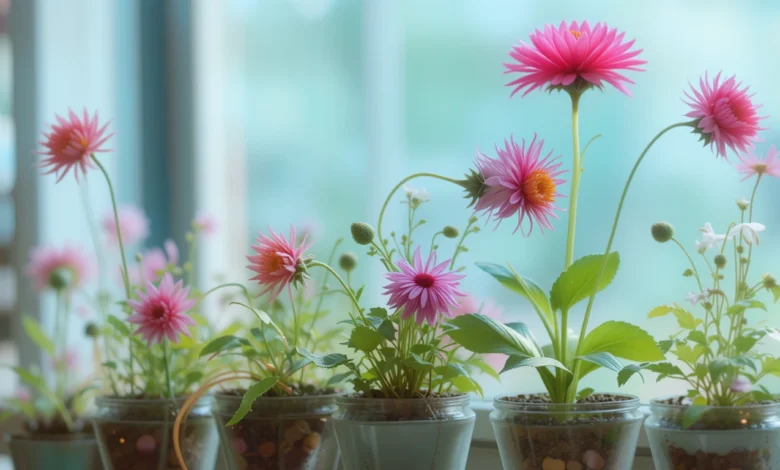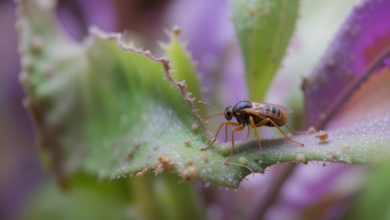How to Grow Flowers Indoors – Easy Tips for Stunning Blooms

Do you dream of having a beautiful garden inside your home? Growing flowers indoors is a fun and rewarding activity that anyone can do, regardless of whether you have a large garden or just a small space. Flowers not only add beauty to your home, but they also bring positive energy, improve air quality, and even help you relax. In this ultimate guide, we’ll show you how to grow flowers indoors, provide tips on how to care for them, and share some common indoor flowers that thrive in a cozy indoor environment.
Let’s dive into the wonderful world of indoor gardening!
Why Grow Flowers Indoors?
You might wonder, why should I grow flowers indoors when I can just enjoy them outside? Well, there are many great reasons to start growing flowers inside your home!
1. Bring Nature Indoors
Flowers add a natural touch to your indoor environment. They create a calming, peaceful atmosphere and help make your living space feel more welcoming. The beauty of flowers is hard to match, whether they are blooming in bright colors or have a subtle fragrance.
2. Clean the Air
Did you know that indoor plants, including flowers, can purify the air? Flowers like peace lilies and spider plants can absorb harmful toxins in the air and release fresh oxygen. This helps to improve the overall air quality inside your home.
3. Improve Mood and Reduce Stress
Many studies show that being around plants can make you feel better. Looking at flowers or spending time caring for them can help reduce stress and anxiety, and even make you happier. The calm energy that flowers provide can make a big difference in your day-to-day life.
4. All-Year-Round Blooms
With indoor flowers, you can enjoy beautiful blooms no matter what season it is. While outdoor gardens may go dormant in winter, your indoor flowers will continue to thrive, bringing color and life to your space year-round.
Choosing the Right Flowers for Indoors
Not all flowers can grow indoors, but there are many beautiful and easy-to-care-for options that thrive inside. When selecting flowers for your indoor garden, you’ll want to consider factors like light, temperature, and humidity. Here are some of the best flowers to grow indoors:
1. Peace Lily
Peace lilies are one of the most popular indoor plants. They are known for their beautiful white flowers and their ability to thrive in low light conditions. Peace lilies are also great air purifiers, helping to clean the air in your home. They’re easy to care for, as they only need to be watered when the soil feels dry.
2. African Violet
African violets are perfect for adding a pop of color to your home. They come in various shades of purple, blue, and even white. These plants prefer moderate light and should be kept in a location with indirect sunlight. African violets also bloom continuously, making them an ideal choice for indoor gardens.
3. Orchids
Orchids are elegant and unique flowers that can add a touch of luxury to your home. They are known for their long-lasting blooms and come in a variety of colors and patterns. Orchids require more care than some other indoor flowers, but with the right environment, they can thrive indoors. They need bright, indirect light and must be watered carefully to avoid root rot.
4. Begonias
Begonias are another popular choice for indoor gardens. They have beautiful flowers in shades of red, pink, and white, and their waxy leaves add an attractive touch. Begonias prefer moderate to bright light and should be watered when the soil is dry to the touch. They’re perfect for beginners because they’re easy to care for and adapt well to indoor conditions.
5. Geraniums
Geraniums are known for their vibrant flowers in colors like red, pink, and white. These flowers require a lot of sunlight to grow well, so it’s important to place them near a bright window or under a grow light. Geraniums are easy to care for and make great indoor flowers if you can provide them with the right conditions.
Setting Up the Perfect Indoor Flower Garden
To help your flowers grow and thrive, you need to provide them with the right environment. Here are the key factors to consider when setting up your indoor garden:
1. Light Requirements
Light is one of the most important things flowers need to grow. Most indoor flowers need bright, indirect sunlight to stay healthy. If your home doesn’t get enough natural light, you can use artificial grow lights to supplement the sunlight.
- Low Light Flowers: If you have a room with limited sunlight, peace lilies and snake plants are excellent options.
- Bright Light Flowers: Flowers like geraniums, orchids, and African violets need more direct sunlight to bloom and grow well.
2. Temperature
Indoor flowers generally thrive in temperatures between 65°F to 75°F (18°C to 24°C). You should keep them away from heat sources like radiators or air conditioners, as these can cause temperature fluctuations that may stress the plants. A consistent, moderate temperature is best for most indoor flowers.
3. Humidity
Humidity is another important factor to consider when growing flowers indoors. Some flowers, such as orchids, prefer higher humidity levels. If you live in a dry area, you can increase the humidity by placing a small humidifier near your plants or by misting them lightly with water. On the other hand, most indoor flowers will do fine with average humidity levels.
4. Containers and Soil
Choosing the right pot and soil is essential for the success of your indoor flowers. Ensure that your pots have drainage holes to prevent water from collecting at the bottom, which can lead to root rot. Use a well-draining potting mix that’s specifically designed for indoor plants.
Read More: 5 Simple Ways to Grow a Lush, Eco-Friendly Chemical-Free Lawn
Watering and Feeding Your Flowers
Proper watering is crucial for indoor flowers. Overwatering or underwatering can harm your plants, so it’s important to get it right.
How to Water Indoor Flowers:
- When to Water: Check the soil by sticking your finger about an inch into the soil. If it feels dry, it’s time to water. Avoid watering too often, as this can cause the roots to rot.
- How Much to Water: Water the plant until you see some water draining out from the bottom of the pot. Make sure not to leave excess water in the saucer, as this can lead to root rot.
Fertilizing Indoor Flowers:
Indoor flowers need nutrients to grow strong and healthy. Use a balanced, water-soluble fertilizer to feed your plants. During the growing season (spring and summer), you can fertilize once every two weeks. In fall and winter, reduce the frequency of fertilizing since the flowers are in a dormant period.
Preventing Pests and Diseases
Just like outdoor plants, indoor flowers can be affected by pests and diseases. Here are some common pests and how to deal with them:
- Aphids: These tiny insects suck the sap from your plants and can cause damage. To remove aphids, gently wash the leaves with water or use an insecticidal soap.
- Spider Mites: These pests create small webs on your plants and cause the leaves to turn yellow. To control spider mites, wipe the leaves with a damp cloth or use a mild insecticidal soap.
Regularly check your plants for signs of pests or diseases, and take action quickly if you notice any problems.
Repotting and Pruning Indoor Flowers
As your flowers grow, they may need to be repotted or pruned.
Repotting:
Indoor flowers should be repotted every 1-2 years or when they outgrow their pots. When repotting, choose a pot that is 1-2 inches larger in diameter than the current one. Gently remove the plant from the old pot and place it in the new one with fresh potting soil.
Pruning:
Pruning is essential for keeping your flowers healthy and encouraging new growth. Trim dead or yellowing leaves and faded flowers to promote better airflow and prevent disease. Use clean, sharp scissors to make clean cuts.
Conclusion: Growing Indoor Flowers Is Easy and Fun!
Growing flowers indoors is a fun and rewarding hobby that anyone can try. With the right flowers, proper care, and a little attention, you can enjoy beautiful blooms in your home year-round. Remember to provide your flowers with the right light, temperature, and humidity, and make sure they get enough water and nutrients. Keep an eye out for pests, and don’t forget to prune and repot when necessary.
Now that you know the basics, it’s time to get started on your indoor flower garden. Whether you choose peace lilies, orchids, or African violets, your flowers will bring beauty and joy to your home. Happy gardening!




